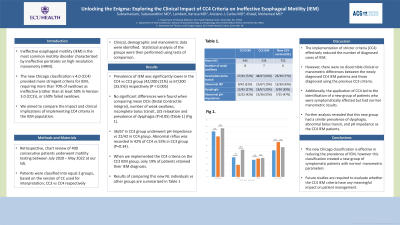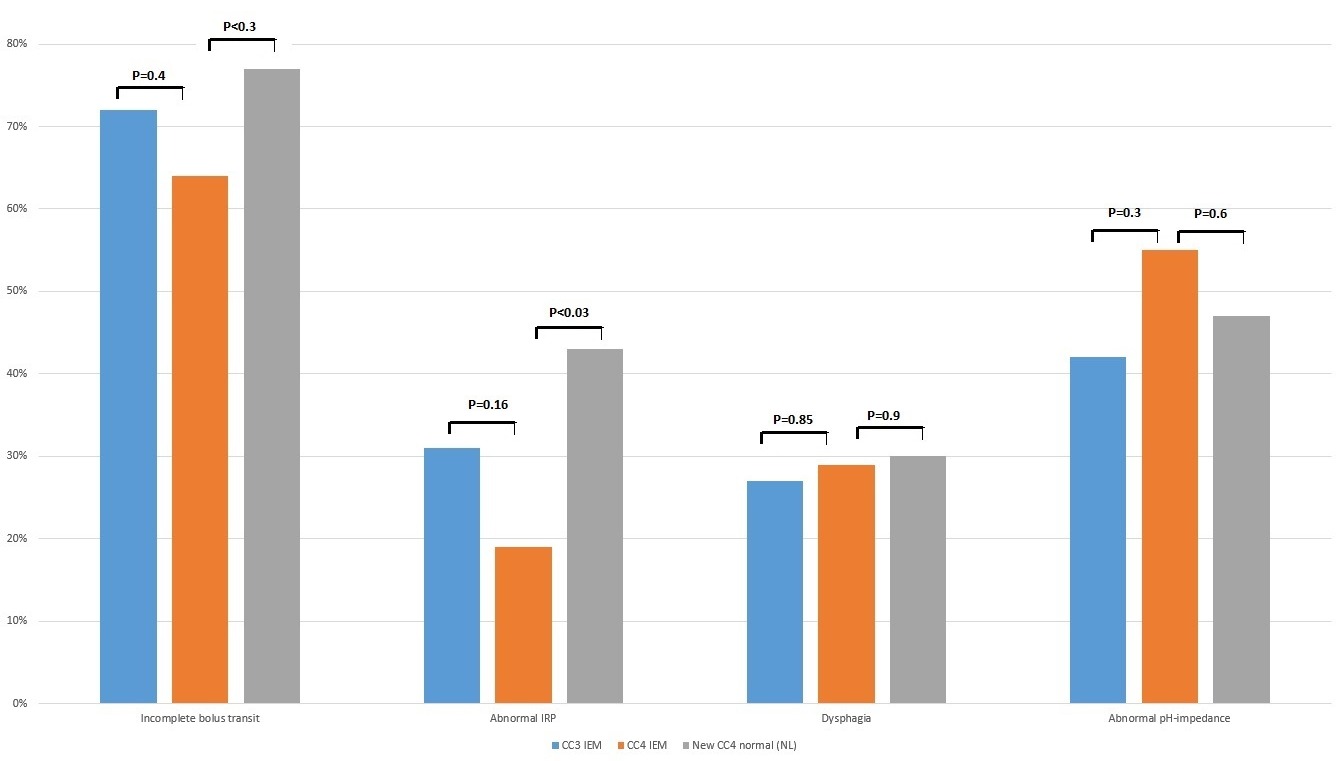Tuesday Poster Session
Category: Esophagus
P3262 - Unlocking the Enigma: Exploring the Clinical Impact of Chicago Classification V4.0 Criteria on Ineffective Esophageal Motility
Tuesday, October 24, 2023
10:30 AM - 4:00 PM PT
Location: Exhibit Hall

Has Audio
- SP
Subanandhini Subramaniam Parameshwari, MD
East Carolina University Brody School of Medicine
Winterville, NC
Presenting Author(s)
Subanandhini Subramaniam. Parameshwari, MD1, Karissa Lambert, MD2, Carlos Anciano, MD3, Mohamed Khalaf, MD3
1East Carolina University Brody School of Medicine, Greenville, NC; 2ECU Health Medical Center, Greenville, NC; 3ECU Health, Greenville, NC
Introduction: Ineffective esophageal motility (IEM) is the most common motility disorder characterized by ineffective peristalsis on high-resolution manometry (HRM). The new Chicago classification Version 4.0 (CC4) provided more stringent criteria for IEM, requiring more than 70% of swallows as ineffective (rather than at least 50% in Version 3.0 (CC3)), or ≥50% failed swallows. We aimed to compare the impact and clinical implications of implementing CC4 criteria in the IEM population.
Methods: Retrospective chart review of 400 consecutive patients who underwent motility testing between July 2020 – May 2022 at our lab. Patients were classified into 2 equal groups, based on the version of CC used for interpretation; CC3 vs CC4 respectively. Clinical, demographic and manometric data were identified. Statistical analysis of the groups was then performed using tests of comparison.
Results: Prevalence of IEM was significantly lower in the CC4 vs CC3 group (42/200 (21%) vs 67/200 (33.5%)), respectively (P < 0.005). No significant differences were found when comparing mean DCIs (Distal Contractile Integral), number of weak swallows, incomplete bolus transit, LES relaxation and prevalence of dysphagia (P >0.05) (Table 1) (Fig 1). 36/67 in CC3 group underwent pH-Impedance vs 22/42 in CC4 group. Abnormal reflux was recorded in 42% of CC4 vs 55% in CC3 group (P=0.34). When we implemented the CC4 criteria on the CC3 IEM group, only 19% of patients retained their IEM diagnosis and 14.5% were considered normal (NL). Results of comparing this new NL individuals vs other groups are summarized in Table 1.
Discussion: The implementation of stricter criteria (CC4) effectively reduced the number of diagnosed cases of IEM. However, there were no discernible clinical or manometric differences between the newly diagnosed CC4 IEM patients and those diagnosed using the previous CC3 criteria. Additionally, the application of CC4 led to the identification of a new group of patients who were symptomatically affected but had normal manometric results. Further analysis revealed that this new group had a similar prevalence of dysphagia, abnormal bolus transit, and pH impedance as the CC4 IEM patients. Future studies are required to evaluate whether the CC4 IEM criteria have any meaningful impact on patient management.

Disclosures:
Subanandhini Subramaniam. Parameshwari, MD1, Karissa Lambert, MD2, Carlos Anciano, MD3, Mohamed Khalaf, MD3. P3262 - Unlocking the Enigma: Exploring the Clinical Impact of Chicago Classification V4.0 Criteria on Ineffective Esophageal Motility, ACG 2023 Annual Scientific Meeting Abstracts. Vancouver, BC, Canada: American College of Gastroenterology.
1East Carolina University Brody School of Medicine, Greenville, NC; 2ECU Health Medical Center, Greenville, NC; 3ECU Health, Greenville, NC
Introduction: Ineffective esophageal motility (IEM) is the most common motility disorder characterized by ineffective peristalsis on high-resolution manometry (HRM). The new Chicago classification Version 4.0 (CC4) provided more stringent criteria for IEM, requiring more than 70% of swallows as ineffective (rather than at least 50% in Version 3.0 (CC3)), or ≥50% failed swallows. We aimed to compare the impact and clinical implications of implementing CC4 criteria in the IEM population.
Methods: Retrospective chart review of 400 consecutive patients who underwent motility testing between July 2020 – May 2022 at our lab. Patients were classified into 2 equal groups, based on the version of CC used for interpretation; CC3 vs CC4 respectively. Clinical, demographic and manometric data were identified. Statistical analysis of the groups was then performed using tests of comparison.
Results: Prevalence of IEM was significantly lower in the CC4 vs CC3 group (42/200 (21%) vs 67/200 (33.5%)), respectively (P < 0.005). No significant differences were found when comparing mean DCIs (Distal Contractile Integral), number of weak swallows, incomplete bolus transit, LES relaxation and prevalence of dysphagia (P >0.05) (Table 1) (Fig 1). 36/67 in CC3 group underwent pH-Impedance vs 22/42 in CC4 group. Abnormal reflux was recorded in 42% of CC4 vs 55% in CC3 group (P=0.34). When we implemented the CC4 criteria on the CC3 IEM group, only 19% of patients retained their IEM diagnosis and 14.5% were considered normal (NL). Results of comparing this new NL individuals vs other groups are summarized in Table 1.
Discussion: The implementation of stricter criteria (CC4) effectively reduced the number of diagnosed cases of IEM. However, there were no discernible clinical or manometric differences between the newly diagnosed CC4 IEM patients and those diagnosed using the previous CC3 criteria. Additionally, the application of CC4 led to the identification of a new group of patients who were symptomatically affected but had normal manometric results. Further analysis revealed that this new group had a similar prevalence of dysphagia, abnormal bolus transit, and pH impedance as the CC4 IEM patients. Future studies are required to evaluate whether the CC4 IEM criteria have any meaningful impact on patient management.

Figure: Comparison of the Results of Incomplete Bolus Transit, Abnormal IRP, Dysphagia, Abnormal pH Impedance Between the Groups
Disclosures:
Subanandhini Parameshwari indicated no relevant financial relationships.
Karissa Lambert indicated no relevant financial relationships.
Carlos Anciano indicated no relevant financial relationships.
Mohamed Khalaf indicated no relevant financial relationships.
Subanandhini Subramaniam. Parameshwari, MD1, Karissa Lambert, MD2, Carlos Anciano, MD3, Mohamed Khalaf, MD3. P3262 - Unlocking the Enigma: Exploring the Clinical Impact of Chicago Classification V4.0 Criteria on Ineffective Esophageal Motility, ACG 2023 Annual Scientific Meeting Abstracts. Vancouver, BC, Canada: American College of Gastroenterology.

